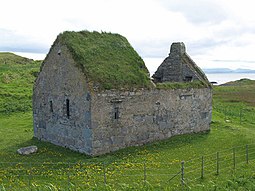Eilean Mòr, MacCormaig Isles
| Meaning of name | Big isle |
|---|---|
 St Cormac's Chapel | |
| Location | |
| OS grid reference | NR666753 |
| Coordinates | 55°54′52″N 5°44′09″W / 55.914477°N 5.735721°W |
| Physical geography | |
| Island group | MacCormaig Isles |
| Area | 18 hectares (0.07 sq mi)[1] |
| Highest elevation | 21 metres (69 ft) |
| Administration | |
| Council area | Argyll and Bute |
| Country | Scotland |
| Sovereign state | United Kingdom |
| Demographics | |
| Population | 0 |
Eilean Mòr ("Big Isle") is one of the MacCormaig Isles situated near the entrance to Loch Sween in the Sound of Jura, Argyll and Bute, Scotland. Eilean Mòr is uninhabited.[2]
Eilean Mòr is the largest of the MacCormaig Islands, and is a breeding ground for seabirds.[3] The island is the legendary retreat of the 7th-century Saint Cormac.[3] It has three ancient monuments on it in the care of Historic Environment Scotland: a cave, a chapel and a cross.[4] The island was bequeathed to the Scottish National Party in 1978, and it has been managed since 2000 by a charitable trust.[5]
St Cormac's Cave
St Cormac's Cave is on the south end of the island.[4] The cave is around 3 metres long, 1 metre wide and 2 metres high, and contains two incised crosses on its east wall, dated by their style to around 700 AD.[4] Saint Cormac (or Cormaic, Carmaig, Charmaig) is an obscure figure; he lived at the beginning of the 7th century and he may have been a son of Cormac, King of Leinster.[6] He is the legendary founder of Keills Chapel 3.5 miles to the north on the Scottish mainland, and he is reputed to have used this cave as his hermitage.[4] The rough stone wall in front of the cave may have been a medieval structure to control pilgrim access to the cave.[4]
St Cormac's Chapel


The chapel is a rectangular building measuring 11.5 x 6 m externally.[7] It was built in the 13th century, and was altered in the 14th century, when John MacDonald, 1st Lord of the Isles had the chancel upgraded.[4] It was converted into a dwelling house around 1700, and used by a tenant of Macneil of Gillchoille, the island’s owner.[4] The chapel was surrounded by a burial ground, now mostly obliterated,[7] but the headless effigy of a medieval cleric can still be seen on the south side of the chancel.[7]
St Cormac's Cross
Beside the chapel stands St Cormac’s Cross, believed to date from the 10th-century.[4] Legend claims that it stands at the west end of the grave of Saint Cormac.[8] Only the shaft and the lower part of the ringed cross survive.[8] It stands 1.75 metres in visible height, but was originally at least 2.8 metres tall.[8] The east face shows two wrestling beak-headed monsters with tails and prominent genitals, above which is a hooded rider astride an oversized horse, and then a large monster gripping a snake in its jaws and linked by its tail and crest to a cruciform group of four animals at the top of the shaft.[8] The decoration on the west face is damaged, but two squatting beasts can be seen with interpenetrating necks and large heads.[8]
Another cross can be seen on the island's highest point, and is a replica of the late 14th-century cross erected by Mariota de Ros, wife of Donald MacDonald, 2nd Lord of the Isles.[4] The original was removed to the National Museum of Scotland in 1937.[4]
References
- ^ "Rick Livingstone’s Tables of the Islands of Scotland" (pdf) Argyll Yacht Charters. Retrieved 23 September 2013.
- ^ "Mor, Eilean". Gazetteer for Scotland. Retrieved 3 March 2019.
- ^ a b Rob Humphreys, Donald Reid (2002), The Rough Guide to Scotland, page 416
- ^ a b c d e f g h i j Eilean Mor: St Cormac's Chapel, Historic Scotland, accessed 13 May 2014 Archived 15 May 2014 at the Wayback Machine
- ^ The Eilean Mór MacCormick Trust Archived 2014-05-14 at the Wayback Machine, accessed 13 May 2014
- ^ Saint Carmaig and Knapdale, Celtic Knapdale, accessed 13 May 2014
- ^ a b c Site Record for Eilean Mor, St Cormac's Chapel And Burial-Ground, RCAHMS, accessed 13 May 2014
- ^ a b c d e Site Record for Eilean Mor, St Cormac's Chapel, Cross, RCAHMS, accessed 13 May 2014
External links
- Historic Environment Scotland: Visitor guide
- Eilean Mor MacCormick - Official website run by the island trustees

